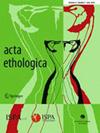Novel observation of play behaviour between a harem holder and a bachelor group of Przewalski’s horses in the wild
Abstract
Abstract
Przewalski’s horses live in stable nonterritorial families (harem) of one or more harem stallions, several mares, and their offspring. The harem stallion typically behaves aggressively towards any male intruder approaching the harem. Play behaviour is frequently observed among the group members in horses. For stallions, the most common, well-known cases of play behaviour are found between members of bachelor groups (groups of young stallions) and between the harem stallion and his offspring. The play between the harem stallion and members of the bachelor groups is, on the other hand, seemingly much rarer as a description of such events in the literature is anecdotal. In this note, we present our observation conducted in the Great Gobi B Strictly Protected Area (Mongolia) and describe the play behaviour between a Przewalski’s horse harem stallion and members of a bachelor group. The observation was done as a part of broader research during which selected Przewalski’s horses’ groups were located by binoculars in daily monitoring routines and filmed from a close distance (from 150 to 800 m). Behavioural Observation Research Interactive Software (BORIS) was used to extract data from the video recordings. The observation described in this note lasted for ∼ 180 min, during which the horses engaged in three separate bouts of play and repeated inter-group association. During the whole study (241.5 h of video recordings), this was the only observation including inter-group interactions. We observed two other events during which two harems approached each other (but never merged). Our observation is the first video recording of such an event and raises the question of how prevalent this behaviour is in the Przewalski’s horses’ restored natural populations. We conclude that this behaviour is unusual or has not been sufficiently studied in wild or feral harems. Further technological advances may help reveal more information on this topic.

 求助内容:
求助内容: 应助结果提醒方式:
应助结果提醒方式:


